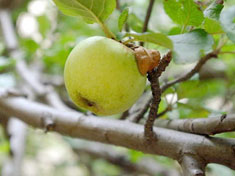An Apple Tree Will Grow in Medford
Tufts gets a cutting from a descendant of the tree Isaac Newton sat beneath when he had his insight into the law of gravitation
By Taylor McNeil

The apple tree Tufts is receiving is a cutting from this one at MIT, descended from one at the Lincolnshire farm where Isaac Newton lived. Photo: Donna Coveney/MIT
Picture this scene: a physics student sits under an apple tree somewhere on the Tufts campus; he gets hit on the noggin by a piece of falling fruit, and—eureka—has a sudden insight into quantum gravity. It might not be likely, but if it did happen, the apple could be a direct descendant of the one that famously dropped on Isaac Newton and led to his theory on the universal law of gravitation.
This spring, Tufts received cuttings from an apple tree that traces its lineage to the Lincolnshire farm where Newton lived in the mid to late 1600s, and while it will be years before the gift will bear fruit, the prospect is still enticing.
When the tree does come to Tufts, it will be thanks to the efforts of Alex Vilenkin, director of the Institute of Cosmology, who has an affinity for Newton’s apple. He started his own ceremony of sorts a few years ago for graduating Ph.D. students in cosmology, dropping an apple on their heads as a way to inspire new approaches to physics. And he’s even been to the site of the original apple’s descent.
“There was a meeting some years ago celebrating 300 years of the publication of Newton’s book Principia, the Philosophiæ Naturalis Principia Mathematica, and we had a little excursion to Newton’s farm in Lincolnshire,” says Vilenkin, the L. and J. Bernstein Professor of Evolutionary Science in the School of Arts and Sciences. “There are apple trees growing there,” and presumably some of them are descendants of the famous apple tree Newton is said to have sat beneath.
Vilenkin knew that MIT had a tree that was a descendant of the apple tree from Newton’s farm, by way of England’s Royal Botanical Gardens at Kew, and hinted to his MIT colleague, physics professor Alan Guth, that it would be nice to have a cutting from the tree to plant at Tufts, in part to celebrate the 20th anniversary of the Institute of Cosmology.
MIT President Susan Hockfield agreed, and John Vik, grounds manager at Tufts, headed to MIT’s Presidential Garden this spring. “I took three good-sized branches,” Vik reports.
He handed them off to George Ellmore, an associate professor of biology in the School of Arts and Sciences, who took them to Phil’s Apples, an orchard in Harvard, Mass., and splice grafted the cuttings onto orchard rootstock. In splice grafting, cuts are made on a diagonal and mated with a similarly cut young tree and bound with tape.
“We’ll know by mid-July whether or not our grafting attempts were successful,” says Ellmore. It’ll be easy to tell: the leaves on it will either be alive or not. “If the grafts are successful,” he adds, “we could plant the tree at Tufts in late fall, once the trees go dormant in November.”
If the grafts aren’t successful, due to incompatibility with the rootstock, the Tufts team will purchase commercial rootstock from a national supplier, graft a new set of branches onto them in the fall and plant them directly at Tufts.
“Either way, there should be a Newton apple tree at Tufts by the end of 2009,” says Ellmore.
Where it would be planted at Tufts, though, is as yet undecided.
And that story about Newton and the apple tree? Actually, Newton apparently said that the idea of universal gravity occurred to him when he saw an apple fall from a tree, and even though that might seem a bit unlikely, “if somebody made it up, it was Newton himself,” says Vilenkin. “From people who wrote about it, some people heard the story from Newton.”
Taylor McNeil can be reached at taylor.mcneil@tufts.edu.

